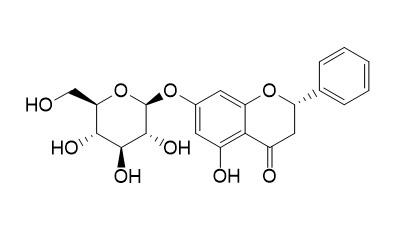Pinocembroside
Pinocembrin-7-O-β-D-glucopyranoside (Pinocembrin 7-O-β-D-Glucoside) is a flavonoid compound that enhances lipid peroxidation
Inquire / Order:
manager@chemfaces.com
Technical Inquiries:
service@chemfaces.com
Tel:
+86-27-84237783
Fax:
+86-27-84254680
Address:
1 Building, No. 83, CheCheng Rd., Wuhan Economic and Technological Development Zone, Wuhan, Hubei 430056, PRC
Providing storage is as stated on the product vial and the vial is kept tightly sealed, the product can be stored for up to
24 months(2-8C).
Wherever possible, you should prepare and use solutions on the same day. However, if you need to make up stock solutions in advance, we recommend that you store the solution as aliquots in tightly sealed vials at -20C. Generally, these will be useable for up to two weeks. Before use, and prior to opening the vial we recommend that you allow your product to equilibrate to room temperature for at least 1 hour.
Need more advice on solubility, usage and handling? Please email to: service@chemfaces.com
The packaging of the product may have turned upside down during transportation, resulting in the natural compounds adhering to the neck or cap of the vial. take the vial out of its packaging and gently shake to let the compounds fall to the bottom of the vial. for liquid products, centrifuge at 200-500 RPM to gather the liquid at the bottom of the vial. try to avoid loss or contamination during handling.
Separations2021, 8(1), 1.
Korean J Environ Agric.2018, 37(4):260-267
Int J Mol Sci.2023, 25(1):283.
Analytical Letters.2020, doi 10.1008
Cells.2021, 10(11):2919.
Appl. Sci. 2021, 11(22), 10552
Appl. Sci.2021, 11(1),14.
J Agric Food Chem.2021, 69(46):14037-14047.
J Agric Food Chem.2018, 66(1):351-358
Antioxidants (Basel).2023, 12(2):447.
Related and Featured Products
Molecules . 2008 Oct 15;13(10):2500-2508.
Two new phenolic glycosides from Viscum articulatum[Pubmed:
18923341]
Two new phenolic glycosides, 1-O-benzyl-[5-O-benzoyl-beta-D-apiofuranosyl (1-->2)]-beta-D-glucopyranoside (1), and 4;-hydroxy-7,3;-dimethoxyflavan-5-O- beta-D-gluco-pyranoside (2), together with nine known flavanones 3 - 11, have been isolated from the dried whole plants of Viscum articulatum.Their structures were identified by extensive spectral analysis, especially 2D NMR techniques. Compound 9 showed weak anti-HIV-1 activity.
Molecules . 2018 Jun 26;23(7):1541.
Phytochemical Composition of the Decoctions of Greek Edible Greens (Chórta) and Evaluation of Antioxidant and Cytotoxic Properties[Pubmed:
29949914]
Wild or semi-wild edible greens (chórta) are an integral part of the traditional Greek Mediterranean diet due to their nutritional value, containing various phytonutrients beneficial to human health. Water-based decoctions of chórta are widely consumed in Greek alternative medicine as health promoting agents. This study examined the chemical profile of the decoctions of eight edible plants, Cichorium intybus, C. endivia, C. spinosum, Crepis sancta, Sonchus asper, Carthamus lanatus, Centaurea raphanina, and Amaranthus blitum, by UPLC-ESI-HRMS and HRMS/MS analysis, to determine possibly bioactive constituents. The profiles of the plants from the Asteraceae family are dominated by the presence of phenolic acids and flavonoid derivatives, whereas the A. blitum decoction is rich in triterpene saponins. Interestingly, the Centaurea raphanina decoction was found to be extremely rich in flavanones, particularly in the aglycone pinocembrin. Further phytochemical investigation and fractionation of this extract resulted in the isolation and identification of five compounds: phlorin (1), syringin (2), pinocembrin (3), Pinocembroside (4), and pinocembrin-7-O-neohesperidoside (5). The extracts were also tested for their antioxidant and differential cytotoxic activity against tumor cells. C. raphanina was found to be differentially toxic against metastatic tumor cells. In conclusion, we found that Greek edible greens are a rich source of bioactive secondary metabolites and their consumption could contribute to the maintenance of overall health.
Molecules . 2022 Mar 21;27(6):2005.
Flavanone Glycosides, Triterpenes, Volatile Compounds and Antimicrobial Activity of Miconia minutiflora (Bonpl.) DC. ( Melastomataceae)[Pubmed:
35335366]
Chemical composition of the essential oils and extracts and the antimicrobial activity of Miconia minutiflora were investigated. The flavanone glycosides, Pinocembroside and pinocembrin-7-O-[4″,6″-HHDP]-β-D-glucose, were identified, along with other compounds that belong mainly to the triterpene class, besides the phenolics, gallic acid and methyl gallate. Sesquiterpenes and monoterpenes were the major compounds identified from the essential oils. Screening for antimicrobial activity from the methanolic extract of the leaves showed that the MIC and MMC values against the tested microorganisms ranged from 0.625 to 5 mg·mL-1 and that the extract was active against microorganisms, Staphyloccocus aureus, Escherichia coli, and Bacillus cereus.



